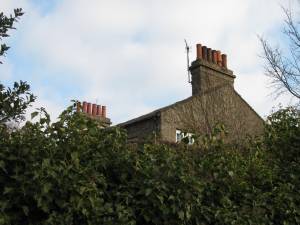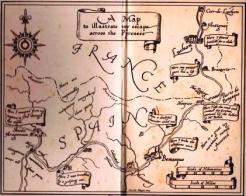 This is a rarity – a novel of Liverpool-Spanish connections, which I came upon while digging around in the Liverpool Record Office archives for sources for my Hispanic Liverpool project. It’s the first of three novels published by the Liverpool ship owner Arthur Behrend (1895-1974), scion of the famous Bahr, Behrend shipping firm, and my copy – courtesy as ever of ABEbooks – is dedicated by the man himself: ‘Alan Bushby’s copy / Arthur Behrend / September 13th, 1935.’ Somehow, that signature makes me very happy.*
This is a rarity – a novel of Liverpool-Spanish connections, which I came upon while digging around in the Liverpool Record Office archives for sources for my Hispanic Liverpool project. It’s the first of three novels published by the Liverpool ship owner Arthur Behrend (1895-1974), scion of the famous Bahr, Behrend shipping firm, and my copy – courtesy as ever of ABEbooks – is dedicated by the man himself: ‘Alan Bushby’s copy / Arthur Behrend / September 13th, 1935.’ Somehow, that signature makes me very happy.*
The novel is narrated by one David Grey, ‘nearing thirty’ and a new recruit at the Armada Steamship Company of Liverpool, run by the rather terrifying Don Pedro, who is:
a man of ability and wealth, his Company of world-wide repute. He claimed direct descent from Don Alonso de Guzmán, Duke of Medina Sidonia and Grand Admiral of Spain; on that account, it seemed, he named each of his ships after a galleon of the Armada. They sailed from Liverpool to South and Central America, to Spain, to Cuba and the Philippines – to wheresoever, in fact, there were Spaniards (p.3).
 The plot centres around David’s increasing suspicions that Don Pedro’s business is not as straightforward as it seems, and that Don Pedro himself is at the centre of illegal activity, perhaps even violent crime. He spends a lot of time staking out Don Pedro’s isolated Wirral property Fen Hall, which is apparently based on the still existing, and still pretty isolated Denna Hall, near Neston. Very excitingly, I managed to persuade Mr BooksonSpain that we really needed to take a fieldtrip over to the Wirral to check out the landscape for ourselves (the bribe of lunch at the Boathouse in Parkgate may have had something to do with his surprisingly enthusiastic agreement…). The picture at the top of the post shows the corner of ‘Fen Hall’ – all that’s visible from the road, while the landscape to the right is the marshes in front of the Hall, where much of the novel’s action takes place.
The plot centres around David’s increasing suspicions that Don Pedro’s business is not as straightforward as it seems, and that Don Pedro himself is at the centre of illegal activity, perhaps even violent crime. He spends a lot of time staking out Don Pedro’s isolated Wirral property Fen Hall, which is apparently based on the still existing, and still pretty isolated Denna Hall, near Neston. Very excitingly, I managed to persuade Mr BooksonSpain that we really needed to take a fieldtrip over to the Wirral to check out the landscape for ourselves (the bribe of lunch at the Boathouse in Parkgate may have had something to do with his surprisingly enthusiastic agreement…). The picture at the top of the post shows the corner of ‘Fen Hall’ – all that’s visible from the road, while the landscape to the right is the marshes in front of the Hall, where much of the novel’s action takes place.
Having got himself tangled up both in Don Pedro’s business affairs and with his beautiful daughter Margarita, David is – so he believes – kidnapped by Don Pedro and flung onto one of the company boats leaving for Spain. High jinks then ensue as, with Margarita’s help, he escapes the tiny Pyrenean village where he is being held, and flees back across the Pyrenees to England, before returning to Spain in the company of a Spanish special agent. It’s then that the novel really kicks in, with political intrigue, derring-do, claims, counter-claims, and of course, the inevitable romance. Don Pedro’s business is actually something quite, quite different from what David had understood – and through David’s eyes, we discover that he has chanced upon a significant moment in the course of recent Spanish history:
How could I have known the big bearded man was a rich landowner from the south, famous throughout the Spanish-speaking world as a breeder of fighting bulls? Or guessed the white-haired man with scowling eyes was a Catalan leader, the fat soldier on my left a general with a remarkable record of success and failure in Morocco, the red-haired man a novelist of international fame, the major a renowned aviator, the spectacled man with the mouth of a satyr and the eyes of a poet a Galician schoolmaster of humble origin one day to become president of Spain? Conspirators all, I suppose they were, yet to me they seemed on a higher plane (p.176).
 The novel, which is great fun and includes some beautiful hand-drawn maps like the one I’ve included here, seems to have arisen from Behrend’s experiences in Spain as a young man, although I haven’t yet managed to untangle the entire story. We know from the family papers in the LRO archive that he spent at least 6 months in Bilbao in 1921, learning about the Spanish side of the family business, which also had significant connections in Barcelona. It looks as if this stay was the catalyst for The House of the Spaniard; he states in his history of the family company, Portrait of a Family Firm: Bahr, Behrend & Co., 1793-1945 (1970) that late in 1923, he was given three months’ paid leave from the office by his uncle, in order to finish the novel (p.92).
The novel, which is great fun and includes some beautiful hand-drawn maps like the one I’ve included here, seems to have arisen from Behrend’s experiences in Spain as a young man, although I haven’t yet managed to untangle the entire story. We know from the family papers in the LRO archive that he spent at least 6 months in Bilbao in 1921, learning about the Spanish side of the family business, which also had significant connections in Barcelona. It looks as if this stay was the catalyst for The House of the Spaniard; he states in his history of the family company, Portrait of a Family Firm: Bahr, Behrend & Co., 1793-1945 (1970) that late in 1923, he was given three months’ paid leave from the office by his uncle, in order to finish the novel (p.92).
Behrend’s novel, of course, wouldn’t in the end be published for another twelve years – by which time the political situation in Spain would have changed considerably – but within months of its publication, it was snapped up by Ealing Studios and filmed, on location in the Pyrenees, under the direction of Reginald Denham. I haven’t yet managed to track down a copy of the film, although you can see a 5-minute segment on YouTube, with Brigitte Horney as a heavily German-accented Margarita and Peter Haddon as a frightfully silly-ass David. It’s mostly interior shots, but you get one or two externals that seem to feature typical Wirral cottages, as well as a brief glimpse of the marshes at around 4.00 that very much resembles my photo above, and a mocked-up cover of the Liverpool Echo right in the last frame. I’m very keen to track down the complete film, so if anybody has any leads, please send them this way!
*Behrend’s other two novels, both set in the world of Liverpool shipping, are Unlucky for Some (1955) and The Samarai Affair (1973).

Hello there – Love your “thesis” on the House of the Spaniard. I have seen the film and it doesn’t do justice to the book. The leading man plays it for “laughs” and spoils what is a great story. I may be able to obtain a copy on a CD if you would like one – but no promises. Incidentally, I think you’ll find that the “Spanish” shots were filmed on the banks of the Mersey up by Halewood/Widnes. I was told this by Mr Behrend’s son who I once had the pleasure of talking to about the book. The house in the film is in Burton and is the old Bahrend family home oppostire Denhall Lane.
Hope all this may be of interest, With best wishes – Mike
Hello Mike, and thanks for stopping by. I can’t believe someone else out there has actually read the House of the Spaniard – not to mention seen the film. Am quite envious! We found the old Bahrend house while on our field trip and I took some photos, but had no idea it was used in the film. If you’ve a way of obtaining a copy of the film, I would be hugely grateful – alternatively, if you can point me in the right direction, I’d be very happy to follow it up myself. Feel free to email me direct – links available through ‘about me’ above. And again, thank you!
Hi Mike, I have the film available as VHS
Best Wishes, Jorg
I’m looking for a long time the title of the song that Brigitte Horney sings at the piano, who can help me ?
All the best,
Jorg
kontakt@brigitte-horney.de
I have just edited and published AFB’s autobiography entitled ‘Fragments of an Autobiograhy’. His manuscript was complete up to 1939 when he was packing to rejoin the army at the outbreak of the second World War. I have been able to add a little to his storey. I am his son-in-law, married to his daughter Anne and now living in Bristol. The book has been printed in a small edition not intended for sale but for distribution to friends and family. A couple have been sold with the money going to charity. I will be sending copies to the Liverpool Record Office as well as the University and Ness Gardens which he largely started. His book contains lots of information about his time in Spain, at Bilbao, Barcelona and a shooting party near to Madrid with Jose Luis de Aznar. It also gives full details of his long struggle to get The House of the Spaniard published and the making of the film from the base of his house, Friends Hall
Dear Robert – many thanks for dropping by, and sorry for the delay in approving your comment. I’m very excited to hear about your publication of AFB’s autobiography and would love to purchase a copy, if one is available. I’ll email you! best wishes, Kirsty
The film of ‘The House of the Spaniard ‘ is available now . I think it can be obtained via the BFI
(Ealing Films ) or through ‘Acorn ‘